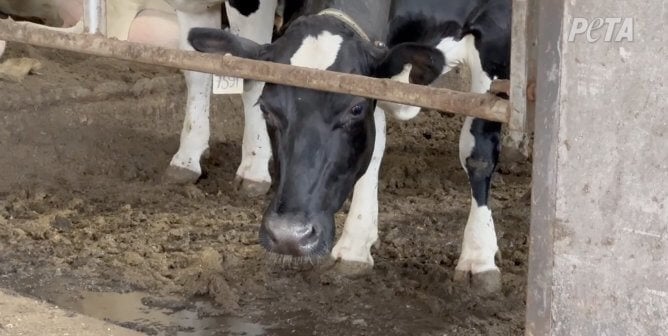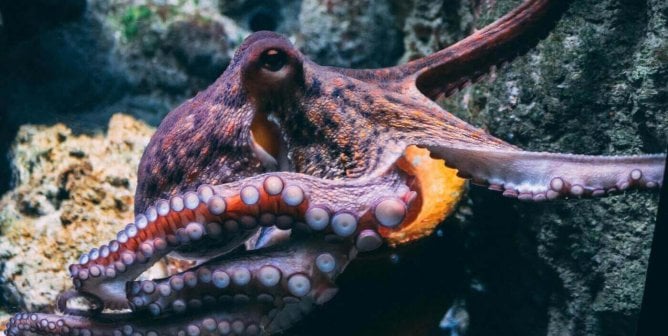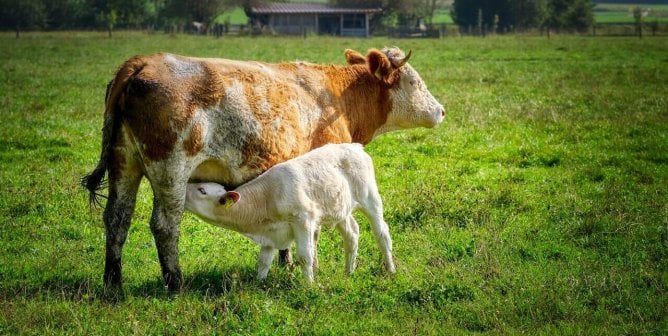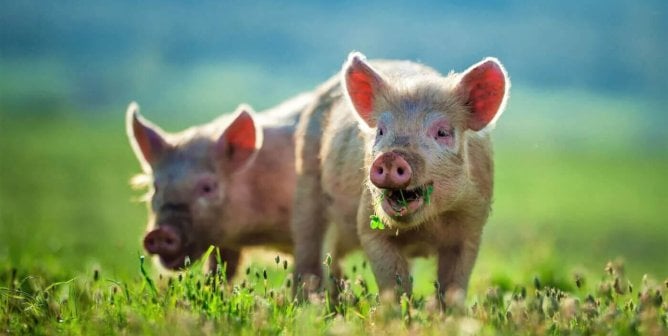Turkeys: Torture on the Holiday Table
Benjamin Franklin called the turkey “a bird of courage” and “a true original native of America.”1 They can fly at speeds of up to 55 miles per hour, run at speeds of up to 25 miles per hour, and live for approximately 10 years.2,3
A British study found that turkeys showed a preference for different kinds of music and sounds, and a poultry scientist said, “If you throw an apple to a group of turkeys, they’ll play with it together.”4,5 Some turkey farmers admit that the birds “are very curious” and show signs of personality.6 Hunters are advised that killing wild turkeys “is not an easy pursuit as gobblers are smart and wary.”7 The millions of turkeys who end up on American dinner plates are genetically manipulated animals who have brief, painful lives on prison-like farms that are far removed from the open spaces enjoyed by their wild cousins.
Wall-to-Wall Misery
About 205 million turkeys are raised for food every year in the U.S.8 Before ending up as holiday centerpieces, these gentle birds spend five to six months on farms, where thousands of turkeys are packed into dark sheds with no more than 3.5 square feet of space per bird.9 To keep the extremely crowded birds from scratching and pecking each other to death, workers cut off portions of the birds’ toes and upper beaks with hot blades and desnood the males (the snood is the flap of skin that runs from the beak to the chest).10 No painkillers are used during these procedures.
Genetic manipulation has enabled farmers to produce heavily muscled birds who can weigh nearly 40 pounds in as little as four months.11 The average turkey destined for today’s dinner table weighs more than 30 pounds, a whopping 56 percent more than his or her peers did in 1960.12 Factory-farmed turkeys are so large that they can barely walk, are unable to fly like their wild cousins, and cannot even engage in normal reproductive behavior, so all turkeys raised for food are conceived by artificial insemination.13
Millions of turkeys don’t even make it past their first few weeks before succumbing to “starve-out,” a stress-induced condition that causes young birds to simply stop eating.14 Catching and transportation are particularly stressful procedures for birds, yet they are repeatedly moved during their short lives—from the hatchery to the brooding area to the growing area and finally to the slaughterhouse.15
At the slaughterhouse, turkeys are hung upside down by their weak and crippled legs before their heads are dragged through an electrified “stunning tank,” which immobilizes them but does not kill them. Many birds dodge the tank but then are still conscious when their throats are cut. If the knife fails to properly cut the birds’ throats, then they are dragged through the scalding-hot water of the defeathering tank while still alive and conscious.
Investigations Reveal Intentional Cruelty
In 2021, a PETA investigator worked for Plainville Farms, a New Oxford, Pennsylvania-based company that claims to produce “humane” turkey in a “stress-free environment.” PETA’s investigator saw workers attack birds to instill fear, vent frustration, or relieve boredom. They kicked, stomped on and threw birds through the air by the wing, neck, head, and snood. They tied their snoods together and laughed as the terrified birds were jostled around in the packed confines of the chute. They hit them with an iron bar and stood on their heads. They choked and throttled them, and they wrung and broke their necks. They used the turkeys’ bodies to mimic sex acts. For more information on this investigation, please visit PETA.org.
In 2006, undercover PETA investigators worked at a Butterball plant in Arkansas and observed that live birds were slammed against transport trucks and walls, punched and kicked, hung by their broken legs, used as punching bags, and even sexually assaulted. One worker was seen crushing a live turkey’s head under his shoe until the bird’s skull exploded, and another slammed a bird against a handrail so hard that her spine was exposed. For more information about this investigation, please visit ButterballCruelty.com.
A PETA investigation of Minnesota-based Crestview Farm revealed that the farm’s manager repeatedly used a metal pipe to bludgeon 12-week-old turkeys who were lame, injured, ill, or otherwise unsuitable for slaughter and consumption. Injured birds were thrown onto piles of dead and dying birds, and then they were tossed into a wheelbarrow for disposal. Birds who were still alive were kicked or beaten with pliers or had their necks wrung—all in full view of other terrified birds. When the Minnesota Turkey Growers Association came to the defense of the farmer, the local district attorney refused to prosecute. More details and photos from this case are available at PETA.org.
Turkey Flesh Linked to Disease
Turkey flesh is devoid of fiber and loaded with more fat and cholesterol than many cuts of beef. A turkey’s leg contains more than 450 milligrams of cholesterol and more than 1,100 calories—40 percent of which are derived from fat.16
The USDA estimates that an average of one out of fifty turkeys is infected with salmonella, a foodborne illness that sickens more than 1 million people each year and kills 420.17,18 Campylobacter, a type of bacteria found in turkeys, is one of the most common causes of diarrhea in the United States.19
What You Can Do
Spread some holiday joy to turkeys by sparing their lives. Look in supermarkets and health food stores or on the Internet for Tofurky, Tofu Turkey, Garden Protein’s Veggie Turkey Breast, Field Roast, and other widely available turkey alternatives. For more information on vegetarian holiday meals, go to PETA.org for great recipes, nutritional information, and cooking and shopping tips as well as to order a free copy of our vegetarian/vegan starter kit.
Resources
Garden Protein International
604-278-7300
http://www.gardein.com
Tofurky
1-800-508-8100
www.tofurky.com
Tofu Turkey
610-433-4711
www.freshtofu.com
References
1Benjamin Franklin, “To Mrs. Sarah Bache,” 26 Jan. 1784, in The Writings of Benjamin Franklin, ed. Albert Henry Smyth (New York: The Macmillan Company, 1905-1907).
2Lake Erie Nature & Science Center, “8 Wild Facts About Wild Turkeys,” accessed 3 Nov. 2024.
3Maine Department of Inland Fisheries & Wildlife, “Wild Turkey,” accessed 3 Nov. 2024.
4Andrea Gerlin, “Researchers Examine Music’s Impact on Turkeys,” Knight Ridder Newspapers, 26 Nov. 2003.
5Aaron Hougham, “Turkeys—Not as Dumb as You Think,” The Daily Barometer 26 Nov. 2003.
6Arthur Hirsch,”Home Before the Holidays. At Springfield Farm in Sparks, Turkeys Roam Free Before Turning Up on the Thanksgiving Table,” The Baltimore Sun 26 Nov. 2003.
7“Where You Can Hunt Spring Turkey in Virginia,” Department of Game and Inland Fisheries, 2018.
8National Agricultural Statistics Service, “Turkeys Raised,” U.S. Department of Agriculture, 27 Sept. 2024.
9Virginia Polytechnic Institute and State University, “Crop Profile for Turkey in Virginia,” Mar. 2006.
10Ibid.
11Danielle Clarke et al., “Continual Selection for Increased 16 wk Body Weight on Turkey Growth and Meat Quality: 50 Generation Update,” Journal of Applied Poultry Research 3(2018): 658-668.
12Alexis C. Madrigal, “The Supersized American Turkey,” The Atlantic, 27 Nov. 2013.
13Nicholas Staropoli, “Your Turkey May Be Organic, But It’s Not Natural,” American Council on Science and Health, 23 Nov. 2015.
14“Non-starter and ‘Starve-out’s’,” The Poultry Site, accessed 6 Oct, 2018.
15Poultry Service Association, “Poultry Handling and Transportation Manual,” 2017.
16U.S. Department of Agriculture, Agricultural Research Service, Nutrient Data Laboratory, National Nutrient Database for Standard Reference, “Turkey, All Classes, Leg, Meat and Skin, Cooked, Roasted,” Release April 1, 2019.
17Elizabeth Weise, “Don’t Wash Your Turkey! And Other Food Safety Tips,” USA Today, 17 Nov. 2012.
18U.S. Department of Health and Human Services, Centers for Disease Control and Prevention, “Salmonella,” 5 Dec. 2019.
19U.S. Department of Health and Human Services, Centers for Disease Control and Prevention, “Campylobacter (Campylobacteriosis),” 10 May. 2024.








